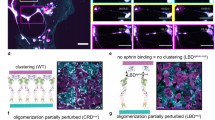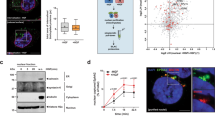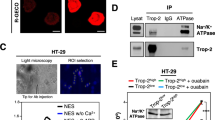Abstract
EpCAM was found to be overexpressed on epithelial progenitors, carcinomas and cancer-initiating cells. The role of EpCAM in proliferation, and its association with cancer is poorly explained by proposed cell adhesion functions. Here we show that regulated intramembrane proteolysis activates EpCAM as a mitogenic signal transducer in vitro and in vivo. This involves shedding of its ectodomain EpEX and nuclear translocation of its intracellular domain EpICD. Cleavage of EpCAM is sequentially catalysed by TACE and presenilin-2. Pharmacological inhibition or genetic silencing of either protease impairs growth-promoting signalling by EpCAM, which is compensated for by EpICD. Released EpICD associates with FHL2, β-catenin and Lef-1 to form a nuclear complex that contacts DNA at Lef-1 consensus sites, induces gene transcription and is oncogenic in immunodeficient mice. In patients, EpICD was found in nuclei of colon carcinoma but not of normal tissue. Nuclear signalling of EpCAM explains how EpCAM functions in cell proliferation.
This is a preview of subscription content, access via your institution
Access options
Subscribe to this journal
Receive 12 print issues and online access
$209.00 per year
only $17.42 per issue
Buy this article
- Purchase on Springer Link
- Instant access to full article PDF
Prices may be subject to local taxes which are calculated during checkout







Similar content being viewed by others
References
Gires, O. TACSTD1 (tumour-associated calcium signal transducer 1). Atlas Genet. Cytogenet. Oncol. Haematol., http://AtlasGeneticsOncology.org/Genes/TACSTD1ID42459ch2p21.html (2008).
Went, P. et al. Frequent high-level expression of the immunotherapeutic target Ep-CAM in colon, stomach, prostate and lung cancers. Br. J. Cancer 94, 128–35 (2006).
Spizzo, G. et al. High Ep-CAM expression is associated with poor prognosis in node-positive breast cancer. Breast Cancer Res. Treat 86, 207–213 (2004).
Litvinov, S. V. et al. Epithelial cell adhesion molecule (Ep-CAM) modulates cell–cell interactions mediated by classic cadherins. J. Cell Biol. 139, 1337–1348 (1997).
Munz, M. et al. The carcinoma-associated antigen EpCAM upregulates c-myc and induces cell proliferation. Oncogene 23, 5748–5758 (2004).
O'Brien, C. A., Pollett, A., Gallinger, S. & Dick, J. E. A human colon cancer cell capable of initiating tumour growth in immunodeficient mice. Nature 445, 106–110 (2007).
Al-Hajj, M., Wicha, M. S., Benito-Hernandez, A., Morrison, S. J. & Clarke, M. F. Prospective identification of tumorigenic breast cancer cells. Proc. Natl Acad. Sci. USA 100, 3983–3988 (2003).
Ricci-Vitiani, L. et al. Identification and expansion of human colon-cancer-initiating cells. Nature 445, 111–115 (2007).
Stingl, J., Eaves, C. J., Zandieh, I. & Emerman, J. T. Characterization of bipotent mammary epithelial progenitor cells in normal adult human breast tissue. Breast Cancer Res. Treat 67, 93–109 (2001).
Schmelzer, E. et al. Human hepatic stem cells from fetal and postnatal donors. J. Exp. Med. 204, 1973–1987 (2007).
Trzpis, M. et al. Expression of EpCAM is upregulated during regeneration of renal epithelia. J. Pathol. (2008).
Ruf, P. et al. Characterisation of the new EpCAM-specific antibody HO-3: implications for trifunctional antibody immunotherapy of cancer. Br. J. Cancer (2007).
Medina, M. & Dotti, C. G. RIPped out by presenilin-dependent gamma-secretase. Cell Signal. 15, 829–841 (2003).
Mumm, J. S. et al. A ligand-induced extracellular cleavage regulates gamma-secretase-like proteolytic activation of Notch1. Mol. Cell 5, 197–206 (2000).
Johannessen, M., Moller, S., Hansen, T., Moens, U. & Van Ghelue, M. c.-r. p.-p. The multifunctional roles of the four-and-a-half-LIM only protein FHL2. Cell. Mol. Life Sci. 63, 268–284 (2006).
Li, M. et al. The four-and-a-half-LIM protein 2 (FHL2) is overexpressed in gliomas and associated with oncogenic activities. Glia 56, 1328–1338 (2008).
Wang, J. et al. Suppression of FHL2 expression induces cell differentiation and inhibits gastric and colon carcinogenesis. Gastroenterology 132, 1066–1076 (2007).
Wei, Y. et al. Identification of the LIM protein FHL2 as a co-activator of beta-catenin. J. Biol. Chem. 278, 5188–5194 (2003).
Shtutman, M. et al. The cyclin D1 gene is a target of the beta-catenin/LEF-1 pathway. Proc. Natl Acad. Sci. USA 96, 5522–5527 (1999).
Wolfe, M. S. & Kopan, R. Intramembrane proteolysis: theme and variations. Science 305, 1119–1123 (2004).
Canault, M. et al. FHL2 interacts with both ADAM-17 and the cytoskeleton and regulates ADAM-17 localization and activity. J. Cell Physiol. (2006).
Kang, D. E. et al. Presenilins mediate phosphatidylinositol 3-kinase/AKT and ERK activation via select signalling receptors. Selectivity of PS2 in platelet-derived growth factor signalling. J. Biol. Chem. 280, 31537–31547 (2005).
He, T. C. et al. Identification of c-MYC as a target of the APC pathway. Science 281, 1509–1512 (1998).
Yamashita, T., Budhu, A., Forgues, M. & Wang, X. W. Activation of hepatic stem cell marker EpCAM by Wnt-beta-catenin signalling in hepatocellular carcinoma. Cancer Res. 67, 10831–10839 (2007).
Gavert, N. et al. L1, a novel target of beta-catenin signalling, transforms cells and is expressed at the invasive front of colon cancers. J. Cell Biol. 168, 633–642 (2005).
Conacci-Sorrell, M. et al. The shed ectodomain of Nr-CAM stimulates cell proliferation and motility, and confers cell transformation. Cancer Res. 65, 11605–11612 (2005).
Mumm, J. S. & Kopan, R. Notch signalling: from the outside in. Dev. Biol. 228, 151–165 (2000).
Stoeck, A. et al. A role for exosomes in the constitutive and stimulus-induced ectodomain cleavage of L1 and CD44. Biochem. J. 393, 609–618 (2006).
Hampe, W. et al. Ectodomain shedding, translocation and synthesis of SorLA are stimulated by its ligand head activator. J. Cell Sci. 113 Pt 24, 4475–4485 (2000).
Bohm, C. et al. SorLA signalling by regulated intramembrane proteolysis. J. Biol. Chem. (2006).
Taniguchi, Y., Kim, S. H. & Sisodia, S. S. Presenilin-dependent “gamma-secretase” processing of deleted in colorectal cancer (DCC). J. Biol. Chem. 278, 30425–30428 (2003).
Cupers, P., Orlans, I., Craessaerts, K., Annaert, W. & De Strooper, B. The amyloid precursor protein (APP)-cytoplasmic fragment generated by gamma-secretase is rapidly degraded but distributes partially in a nuclear fraction of neurons in culture. J. Neurochem. 78, 1168–1178 (2001).
Oberg, C. et al. The Notch intracellular domain is ubiquitinated and negatively regulated by the mammalian Sel-10 homologue. J. Biol. Chem. 276, 35847–35853 (2001).
Baeuerle, P. A. & Baltimore, D. I kappa B: a specific inhibitor of the NF-kappa B transcription factor. Science 242, 540–546 (1988).
Kenny, P. A. TACE: a new target in epidermal growth factor receptor dependent tumours. Differentiation 75, 800–808 (2007).
Kenny, P. A. & Bissell, M. J. Targeting TACE-dependent EGFR ligand shedding in breast cancer. J. Clin. Invest. 117, 337–345 (2007).
Selkoe, D. J. & Wolfe, M. S. Presenilin: running with scissors in the membrane. Cell 131, 215–221 (2007).
Merchant, N. B. et al. TACE/ADAM-17: a component of the epidermal growth factor receptor axis and a promising therapeutic target in colorectal cancer. Clin. Cancer Res. 14, 1182–1191 (2008).
Reya, T. & Clevers, H. Wnt signalling in stem cells and cancer. Nature 434, 843–850 (2005).
Birchmeier, W. Cell adhesion and signal transduction in cancer. Conference on cadherins, catenins and cancer. EMBO Rep. 6, 413–417 (2005).
Clevers, H. Wnt/beta-catenin signalling in development and disease. Cell 127, 469–480 (2006).
Anderson, R., Schaible, K., Heasman, J. & Wylie, C. Expression of the homophilic adhesion molecule, Ep-CAM, in the mammalian germ line. J. Reprod. Fertil. 116, 379–384 (1999).
Stingl, J., Raouf, A., Emerman, J. T. & Eaves, C. J. Epithelial progenitors in the normal human mammary gland. J. Mammary Gland Biol. Neoplasia 10, 49–59 (2005).
Nagrath, S. et al. Isolation of rare circulating tumour cells in cancer patients by microchip technology. Nature 450, 1235–1239 (2007).
Schmelzer, E., Wauthier, E. & Reid, L. M. The Phenotypes of Pluripotent Human Hepatic Progenitors. Stem Cells (2006).
Baeuerle, P. A. & Gires, O. EpCAM (CD326) finding its role in cancer. Br. J. Cancer 96, 417–423 (2007).
Brock, R., Hamelers, I. H. & Jovin, T. M. Comparison of fixation protocols for adherent cultured cells applied to a GFP fusion protein of the epidermal growth factor receptor. Cytometry 35, 353–362 (1999).
Schagger, H. & von Jagow, G. Blue native electrophoresis for isolation of membrane protein complexes in enzymatically active form. Anal. Biochem. 199, 223–231 (1991).
Gires, O., Mack, B., Rauch, J. & Matthias, C. CK8 correlates with malignancy in leukoplakia and carcinomas of the head and neck. Biochem. Biophys. Res. Commun. 343, 252–259 (2006).
Acknowledgements
Work was supported by funding from the Deutsche Krebshilfe, Mildred-Scheel-Stiftung to M.M. and O.G. We are indebted to Jürgen Haas for technical help. We thank Wenlong Bai for FHL-2–GST constructs. We thank Ralf Schulz for support with in vivo fluorescence imaging. Animal experiments were conducted at the Walter Brendel Center (Director, U. Pohl).
Author information
Authors and Affiliations
Contributions
D.M. and M.M. planned the project, performed experiments and analysed the data; S.D., B.M., M.C., M.B., C.K. and P.P. performed experiments; P.W. provided material support; O.G. planned the project; P.A.B. and O.G. analysed the data and wrote the manuscript.
Corresponding author
Ethics declarations
Competing interests
Markus Munz and Patrick A. Baeuerle are employees of Micromet Inc., Bethesda, Md, USA.
Supplementary information
Supplementary Information
Supplementary Information (PDF 1662 kb)
Rights and permissions
About this article
Cite this article
Maetzel, D., Denzel, S., Mack, B. et al. Nuclear signalling by tumour-associated antigen EpCAM. Nat Cell Biol 11, 162–171 (2009). https://doi.org/10.1038/ncb1824
Received:
Accepted:
Published:
Issue Date:
DOI: https://doi.org/10.1038/ncb1824
This article is cited by
-
Nucleic acid aptasensor with magnetically induced self-assembly for the detection of EpCAM glycoprotein
Microchimica Acta (2024)
-
Comprehensive Review on the Effect of Stem Cells in Cancer Progression
Current Tissue Microenvironment Reports (2024)
-
Epithelial cell adhesion molecule (EpCAM) regulates HGFR signaling to promote colon cancer progression and metastasis
Journal of Translational Medicine (2023)
-
The effects of MYC on tumor immunity and immunotherapy
Cell Death Discovery (2023)
-
EpCAM tumor specificity and proteoform patterns in urothelial cancer
Journal of Cancer Research and Clinical Oncology (2023)



